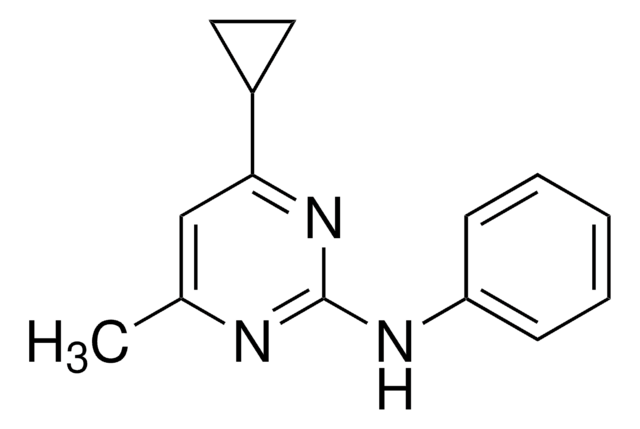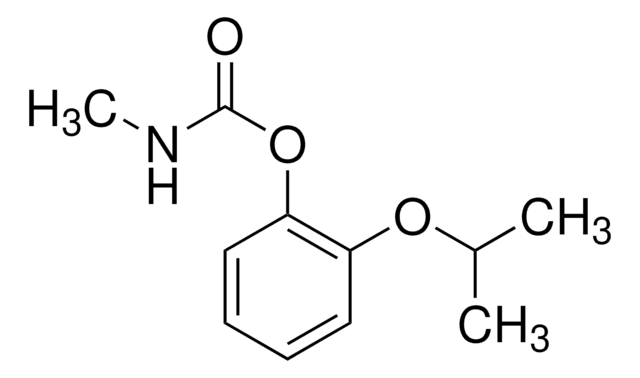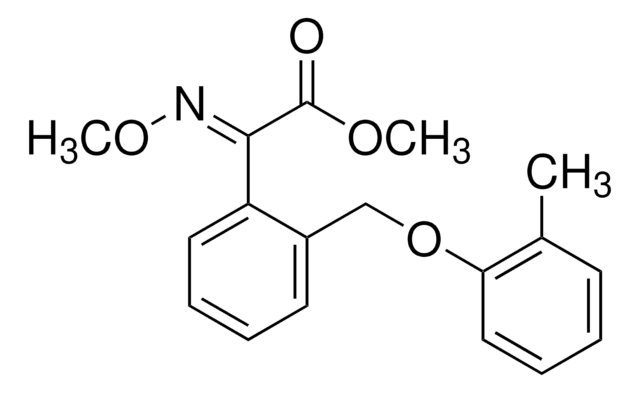46102
Fludioxonil
PESTANAL®, analytical standard
About This Item
Produits recommandés
Qualité
analytical standard
Gamme de produits
PESTANAL®
Durée de conservation
limited shelf life, expiry date on the label
Application(s)
agriculture
environmental
Format
neat
Chaîne SMILES
FC1(F)Oc2cccc(c2O1)-c3c[nH]cc3C#N
InChI
1S/C12H6F2N2O2/c13-12(14)17-10-3-1-2-8(11(10)18-12)9-6-16-5-7(9)4-15/h1-3,5-6,16H
Clé InChI
MUJOIMFVNIBMKC-UHFFFAOYSA-N
Vous recherchez des produits similaires ? Visite Guide de comparaison des produits
Catégories apparentées
Application
- Fludioxonil fungicide in agricultural biotech: Fludioxonil′s effectiveness against the two-component histidine kinase Bos1 in Botrytis cinerea was explored, revealing its binding mode and molecular mechanism. This research underscores its critical role as a fungicide in agricultural biotechnology, providing insights that could lead to improved crop protection strategies (Yin et al., 2024).
- Fludioxonil biochemical research for pathogen resistance: The study on Fusarium species causing soybean root rot examined the genetic basis of differing sensitivities to DMI fungicides, including fludioxonil. This contributes to a deeper understanding of fungal resistance mechanisms, enhancing the development of more effective fungicidal treatments (Zhang et al., 2024).
- Fludioxonil antifungal properties in plant disease control: Research characterized fludioxonil and phenamacril dual resistant mutants of Fusarium graminearum, highlighting fludioxonil′s critical role in managing resistance in pathogens and its ongoing relevance in managing crop diseases (Wen et al., 2024).
Informations légales
Mention d'avertissement
Warning
Mentions de danger
Conseils de prudence
Classification des risques
Aquatic Acute 1 - Aquatic Chronic 1
Code de la classe de stockage
11 - Combustible Solids
Classe de danger pour l'eau (WGK)
WGK 2
Point d'éclair (°F)
Not applicable
Point d'éclair (°C)
Not applicable
Équipement de protection individuelle
Eyeshields, Gloves
Certificats d'analyse (COA)
Recherchez un Certificats d'analyse (COA) en saisissant le numéro de lot du produit. Les numéros de lot figurent sur l'étiquette du produit après les mots "Lot" ou "Batch".
Déjà en possession de ce produit ?
Retrouvez la documentation relative aux produits que vous avez récemment achetés dans la Bibliothèque de documents.
Les clients ont également consulté
Notre équipe de scientifiques dispose d'une expérience dans tous les secteurs de la recherche, notamment en sciences de la vie, science des matériaux, synthèse chimique, chromatographie, analyse et dans de nombreux autres domaines..
Contacter notre Service technique
















